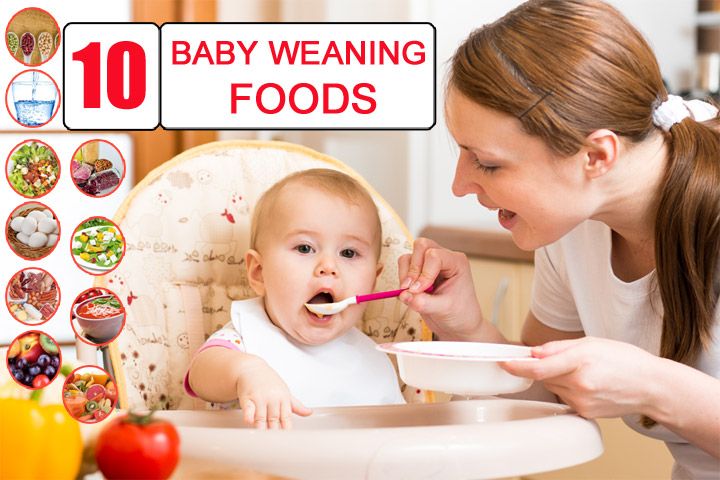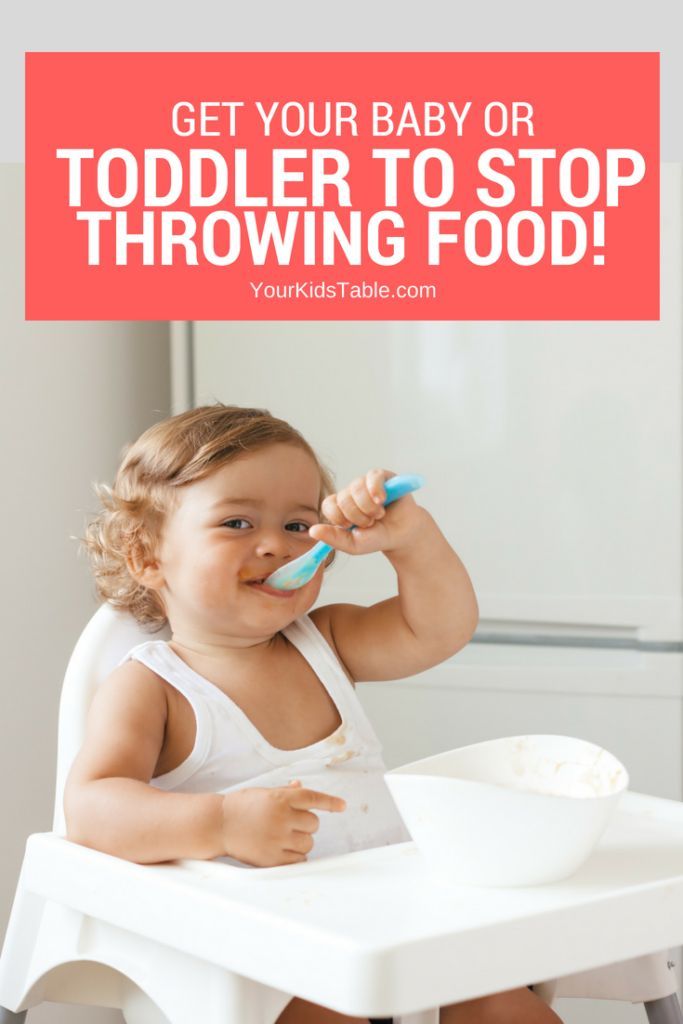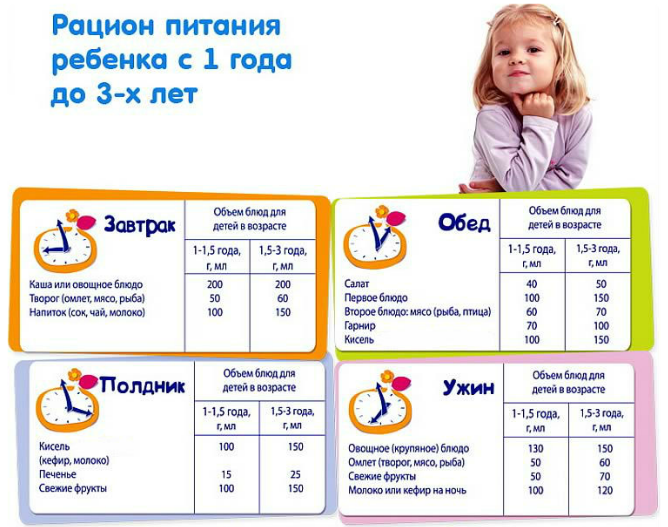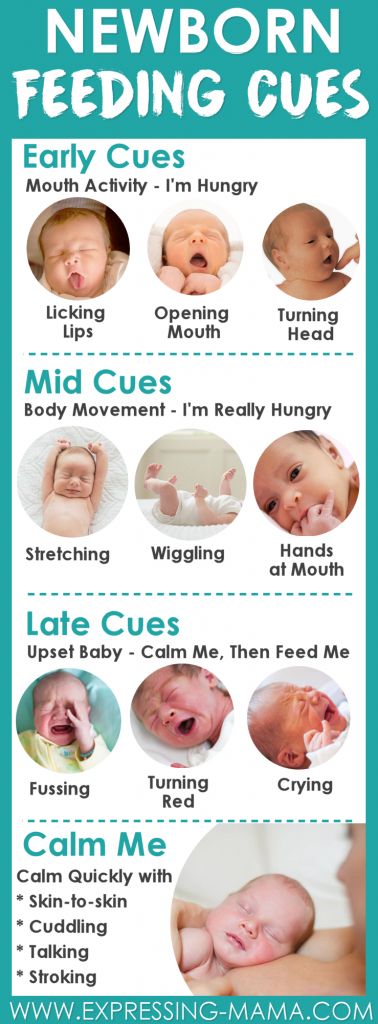How to start feeding your baby
When, What, and How to Introduce Solid Foods | Nutrition
For more information about how to know if your baby is ready to starting eating foods, what first foods to offer, and what to expect, watch these videos from 1,000 Days.
The Dietary Guidelines for Americans and the American Academy of Pediatrics recommend children be introduced to foods other than breast milk or infant formula when they are about 6 months old. Introducing foods before 4 months old is not recommended. Every child is different. How do you know if your child is ready for foods other than breast milk or infant formula? You can look for these signs that your child is developmentally ready.
Your child:
- Sits up alone or with support.
- Is able to control head and neck.
- Opens the mouth when food is offered.
- Swallows food rather than pushes it back out onto the chin.
- Brings objects to the mouth.
- Tries to grasp small objects, such as toys or food.
- Transfers food from the front to the back of the tongue to swallow.
What Foods Should I Introduce to My Child First?
The American Academy of Pediatrics says that for most children, you do not need to give foods in a certain order. Your child can begin eating solid foods at about 6 months old. By the time he or she is 7 or 8 months old, your child can eat a variety of foods from different food groups. These foods include infant cereals, meat or other proteins, fruits, vegetables, grains, yogurts and cheeses, and more.
If your child is eating infant cereals, it is important to offer a variety of fortifiedalert icon infant cereals such as oat, barley, and multi-grain instead of only rice cereal. Only providing infant rice cereal is not recommended by the Food and Drug Administration because there is a risk for children to be exposed to arsenic. Visit the U.S. Food & Drug Administrationexternal icon to learn more.
How Should I Introduce My Child to Foods?
Your child needs certain vitamins and minerals to grow healthy and strong.
Now that your child is starting to eat food, be sure to choose foods that give your child all the vitamins and minerals they need.
Click here to learn more about some of these vitamins & minerals.
Let your child try one single-ingredient food at a time at first. This helps you see if your child has any problems with that food, such as food allergies. Wait 3 to 5 days between each new food. Before you know it, your child will be on his or her way to eating and enjoying lots of new foods.
Introduce potentially allergenic foods when other foods are introduced.
Potentially allergenic foods include cow’s milk products, eggs, fish, shellfish, tree nuts, peanuts, wheat, soy, and sesame. Drinking cow’s milk or fortified soy beverages is not recommended until your child is older than 12 months, but other cow’s milk products, such as yogurt, can be introduced before 12 months. If your child has severe eczema and/or egg allergy, talk with your child’s doctor or nurse about when and how to safely introduce foods with peanuts.
How Should I Prepare Food for My Child to Eat?
At first, it’s easier for your child to eat foods that are mashed, pureed, or strained and very smooth in texture. It can take time for your child to adjust to new food textures. Your child might cough, gag, or spit up. As your baby’s oral skills develop, thicker and lumpier foods can be introduced.
Some foods are potential choking hazards, so it is important to feed your child foods that are the right texture for his or her development. To help prevent choking, prepare foods that can be easily dissolved with saliva and do not require chewing. Feed small portions and encourage your baby to eat slowly. Always watch your child while he or she is eating.
Here are some tips for preparing foods:
- Mix cereals and mashed cooked grains with breast milk, formula, or water to make it smooth and easy for your baby to swallow.
- Mash or puree vegetables, fruits and other foods until they are smooth.

- Hard fruits and vegetables, like apples and carrots, usually need to be cooked so they can be easily mashed or pureed.
- Cook food until it is soft enough to easily mash with a fork.
- Remove all fat, skin, and bones from poultry, meat, and fish, before cooking.
- Remove seeds and hard pits from fruit, and then cut the fruit into small pieces.
- Cut soft food into small pieces or thin slices.
- Cut cylindrical foods like hot dogs, sausage and string cheese into short thin strips instead of round pieces that could get stuck in the airway.
- Cut small spherical foods like grapes, cherries, berries and tomatoes into small pieces.
- Cook and finely grind or mash whole-grain kernels of wheat, barley, rice, and other grains.
Learn more about potential choking hazards and how to prevent your child from choking.
Top of Page
Helpful Resources | Nutrition | CDC
If you would like more information on topics related to feeding your baby or toddler, here are some resources:
General
CDC’s Infant and Toddler Nutrition microsite syndication
CDC offers a free Web Content Syndication service that gives public health partners the opportunity to syndicate CDC content directly to their sites without having to monitor or copy updates. To search the CDC infant and toddler nutrition website available for syndication as well as other resources you can share, visit the CDC Public Health Media Library and browse or search for “infant and toddler nutrition”. Learn more about content syndication and how to add CDC syndicated content on your site.
To search the CDC infant and toddler nutrition website available for syndication as well as other resources you can share, visit the CDC Public Health Media Library and browse or search for “infant and toddler nutrition”. Learn more about content syndication and how to add CDC syndicated content on your site.
CDC’s Child and Teen Resources
This collection of resources provides parents and caregivers, health care providers, and partners with tools and information to help children and teens maintain a healthy weight and prevent obesity.
CDC’s Child Development Positive Parenting Tips (Infants)
This CDC website provides information about infants’ development, as well as tips for positive parenting and promoting the safety and health of infants.
CDC’s Learn the Signs. Act Early.
This website includes tools to track children’s milestones and resources about children’s development.
CDC’s Parent Information
This CDC website provides resources and information on pregnancy, infants and toddlers, children, and teens. Learn how to handle common parenting challenges through interactive activities, videos, and more. Healthcare professionals and researchers can also find information on children’s health and safety.
Learn how to handle common parenting challenges through interactive activities, videos, and more. Healthcare professionals and researchers can also find information on children’s health and safety.
CDC’s Division of Oral Health
Tooth decay (cavities) is one of the most common chronic diseases of childhood in the United States. Untreated tooth decay can cause pain and infections that may lead to problems with eating, speaking, playing, and learning. CDC’s Division of Oral Health provides information on what parents and caregivers can do to ensure good oral health for your child.
Dietary Guidelines for Americans 2020–2025 pdf icon[PDF-30.6MB]external icon
These guidelines provide science-based advice for Americans on what to eat and drink to promote health, reduce chronic disease, and meet nutrient needs. The 2020–2025 edition provides recommendations for all life stages, including infants and toddlers.
Feeding Guidelines for Infants and Young Toddlers: A Responsive Parenting Approachexternal icon
This report presents recommendations for promoting healthy nutrition and feeding patterns for infants and toddlers from birth to 24 months, with an emphasis on dietary quality, portion sizes, and mealtime environment.
Healthy Childrenexternal icon
This website was developed by the American Academy of Pediatrics for parents. It features thousands of articles in English and Spanish on children’s health and safety, as well as interactive tools.
United States Department of Agriculture Special Supplemental Nutrition Program for Women, Infants, and Children (WIC)external icon
The WIC Program provides support to low-income pregnant, postpartum, and breastfeeding women, babies, and children up to age 5. WIC provides nutritious foods, information on healthy eating, breastfeeding promotion and support, and referrals to health care.
United States Department of Agriculture Supplemental Nutrition Assistance Program (SNAP)external icon
SNAP provides benefits to low-income individuals and families and provides economic benefits to communities.
Feeding and Beverage Recommendationsexternal icon
Healthy Eating Research, a national program of the Robert Wood Johnson Foundation, offers science-based recommendations for parents and caregivers. Tips are available for feeding children from birth through 24 monthsexternal icon and beverages for children from birth through 5 yearsexternal icon. Tips for older children are also available.
Tips are available for feeding children from birth through 24 monthsexternal icon and beverages for children from birth through 5 yearsexternal icon. Tips for older children are also available.
U.S. Food and Drug Administration (FDA) and Environmental Protection Agency’s (EPA) Advice About Eating Fishexternal icon
The U.S. FDA and EPA provide advice regarding eating fish. This advice can help people make informed choices when it comes to the types of fish that are nutritious and safe to eat. It is especially important for those who might become pregnant, who are pregnant, or who are breastfeeding, as well as for parents and caregivers who are feeding children. This advice supports the recommendations of the Dietary Guidelines for Americans.
Top of Page
Breastfeeding
CDC’s Breastfeeding Information
CDC’s Division of Nutrition, Physical Activity, and Obesity (DNPAO) is committed to increasing breastfeeding rates throughout the United States. CDC provides information for public health professionals and others to help support breastfeeding mothers, such as managing breastfeeding during various maternal and infant illnesses and conditions, any precautions for vaccines during breastfeeding, and recommendations for proper storage and handling of expressed human milk.
CDC provides information for public health professionals and others to help support breastfeeding mothers, such as managing breastfeeding during various maternal and infant illnesses and conditions, any precautions for vaccines during breastfeeding, and recommendations for proper storage and handling of expressed human milk.
International Lactation Consultant Association (ILCA)external icon
ILCA is the member association for professionals who care for breastfeeding families. ILCA’s “Find a Lactation Consultant Directory” can help you find a lactation consultant to get the breastfeeding support you need.
United States Lactation Consultant Association (USLCA)external icon
USLCA is a professional association for International Board Certified Lactation Consultants (IBCLCs) and other health care professionals who care for breastfeeding families. USLCA’s “Find an IBCLC” can help you find a lactation consultant to get the breastfeeding support you need.
WIC, the Special Supplemental Nutrition Program for Women, Infants, and Children—Breastfeeding Support external icon
The United States Department of Agriculture Special Supplemental Nutrition Program for Women, Infants, and Children (WIC) Breastfeeding Support website includes resources for expectant and current mothers about breastfeeding, overcoming common challenges, and thriving to make breastfeeding work for their families.
La Leche League USAexternal icon
La Leche League USA helps mothers to breastfeed through mother-to-mother support, encouragement, information, and education and promotes a better understanding of breastfeeding as an important element in the healthy development of the baby and mother.
Office on Women’s Healthexternal icon
The Office on Women’s Health’s vision is for all women and girls to achieve the best possible health outcomes. They provide information on breastfeeding to help women make infant feeding decisions and to guide mothers through the breastfeeding process.
Top of Page
Infant Formula
Questions & Answers for Consumers Concerning Infant Formulaexternal icon
The U.S. Food & Drug Administration regulates infant formula and has a list of questions and answers about infant formula.
Infant Formula Do’s and Don’tsexternal icon
The U.S. Food and Drug Administration provides information on infant formula preparation and storage, as well as other tips on how to keep infant formula safe.
Top of Page
Food Safety
Food Safety Concerns for Children Under Fiveexternal icon
Food safety is particularly important for young children. Foodsafety.gov provides information on safely preparing food for your child.
Top of Page
Meal Time
Fruits & Veggies—Have a Plant Movementexternal icon
A resource designed to help spread the word about the health benefits of adding more fruits and veggies to your diet.
USDA MyPlate Kitchenexternal icon
This online tool features a large collection of recipes and resources to support building healthy and budget-friendly meals. Site features include:
- Extensive search filters on cuisine, cooking equipment, nutrition content, and more.
- Detailed nutrition information.
- Cookbooks to browse and download or build your own.
- Recipe star ratings, review comments, and sharing on social networks.
Video Series on How to Introduce Solid Foods
1,000 Days has developed helpful videos about introducing solid foods to your baby. Topics include:
Topics include:
- Is your baby ready to start eating foods?
- What is a good first food for your baby?
- What to expect when introducing first foods
- How much should I feed my baby?
- How to win at mealtimeexternal icon
- What foods should my baby avoid?
- What should your baby eat in the first year?
Top of Page
Vitamins and Minerals
Vitamin and Mineral Fact Sheetsexternal icon
The National Institutes of Health’s Office of Dietary Supplements has fact sheets for consumers and health professionals about vitamins, minerals, and dietary supplements.
Top of Page
at what age to introduce with breastfeeding and artificial feeding, how to cook at home
When to introduce the first complementary foods
Today there are no hard and fast rules and deadlines for the introduction of complementary foods. Parents should first of all focus on the signs of the child's readiness for complementary foods. Here is what pediatrician, candidate of medical sciences Anna Levadnaya advises to pay attention to , the author of a blog about pediatrics and not only on Instagram.
Here is what pediatrician, candidate of medical sciences Anna Levadnaya advises to pay attention to , the author of a blog about pediatrics and not only on Instagram.
The child holds his head confidently. nine0007
- Can sit with support, meaning it can be placed in a high chair or placed on an adult's lap.
- The kid shows an active interest in food: he is interested in food, he watches what adults eat.
- Breastfeeding or formula feeding is well organized and does not cause any problems.
- The child can put his hand to his mouth, puts various objects in his mouth, such as toys. In this case, the baby chews or champs.
As a rule, all these signs appear in the period from 5.5 to 7.5 - 8 months, but most often around 6 months. All babies develop differently, and one baby may be ready to try his first puree or porridge as early as 5 months, and another at 6 or 7 months will refuse the new food you offer. nine0007
What complementary foods a child needs in the first months
Again, there are no strict recommendations and rules. On the contrary, many experts agree that it doesn’t matter which dish you start complementary foods with, the most important thing is to provide the right nutritional interest. In this case, the child will eat all the foods that you offer him.
On the contrary, many experts agree that it doesn’t matter which dish you start complementary foods with, the most important thing is to provide the right nutritional interest. In this case, the child will eat all the foods that you offer him.
In Russia, it is customary to focus on the following scheme for the introduction of complementary foods. The first to introduce cereals or vegetables, depending on the weight of the child. As a rule, vegetables are first, then cereals, then meat, then fruits, then cottage cheese. In some US states, for example, on the contrary, it is recommended to start complementary foods with meat. But the general message of the recommendations is to maximize the variety of tastes and textures in the first year of life. From vegetables in the first months, you can offer zucchini, cauliflower, broccoli, pumpkin, carrots, potatoes. Of the cereals, gluten-free are the first to be introduced: rice, buckwheat, corn. From fruits - apple, pear, banana, peach and others. From meat - it is better to start with a rabbit, turkey, chicken, veal. nine0007
From meat - it is better to start with a rabbit, turkey, chicken, veal. nine0007
— At the very beginning, complementary foods should be puree-like, says Anna Levadnaya. - It is better to give preference to monocomponent purees so that the baby learns to distinguish between different tastes. As you introduce vegetables and cereals, add butter and vegetable oils to them. If there are no problems with the introduction of complementary foods, it is recommended to use the maximum variety of food textures as early as possible. Starting from 7-8 months, the baby can and should be introduced to semi-solid foods. This is very important for the correct formation of food interest, and for the development of chewing skills, the correct functioning of the tongue, the development of speech, the “tweezer” grip, and the coordination of the work of hands, mouth and eyes. If you do not introduce semi-solid food in time, then there may be problems with the introduction of already solid food, and after a year the child will refuse it completely. Therefore, starting from 7-8 months, the baby can be offered mashed or pureed food, such as a banana. From 8-9months, give the so-called "finger" food: cut into pieces soft fruits and vegetables, such as boiled carrots, potatoes, and put in front of the baby. By one year, the child is ready to eat solid food from the common table.
If you do not introduce semi-solid food in time, then there may be problems with the introduction of already solid food, and after a year the child will refuse it completely. Therefore, starting from 7-8 months, the baby can be offered mashed or pureed food, such as a banana. From 8-9months, give the so-called "finger" food: cut into pieces soft fruits and vegetables, such as boiled carrots, potatoes, and put in front of the baby. By one year, the child is ready to eat solid food from the common table.
How to properly feed your baby
It used to be that complementary foods should be introduced very carefully and gradually, always in the morning, many parents still introduce each product over a week or two, very slowly increasing portions.
- These recommendations are relevant, perhaps, only for the very beginning of complementary foods, the first two or three weeks, - says Anna Levadnaya. - In general, in children without food allergies, the most rapid and varied expansion of the diet is recommended. That is, a new product can be safely introduced every 2-3 days. If you need to breed complementary foods, for example, baby cereals, then it is better to do this with breast milk or formula, and not with cow's. Whole milk is not recommended for children under one year of age. nine0007
That is, a new product can be safely introduced every 2-3 days. If you need to breed complementary foods, for example, baby cereals, then it is better to do this with breast milk or formula, and not with cow's. Whole milk is not recommended for children under one year of age. nine0007
Also with the introduction of complementary foods, offer your child water, either bottled for children or boiled. It is recommended to offer water from a cup so that the child learns to drink, and not from a drinking bowl, a bottle with a tube or a pacifier.
Photo: pexels.com, MART PRODUCTIONMonitor the child's well-being, in case of any changes that worry you, consult a doctor.
Complementary foods with natural and artificial feeding
Mothers often wonder if there are differences in the introduction of complementary foods with natural and artificial feeding. In both cases, the recommendations are the same: it is recommended to focus on food interest, signs of the child's readiness for the introduction of complementary foods. Usually, as we have already noted, the baby receives only breast milk or an adapted milk formula up to 6 months. With exclusive breastfeeding, it is not recommended to supplement the baby with water, especially in the first month, when lactation is established. Bottle-fed babies can be offered water. nine0007
Usually, as we have already noted, the baby receives only breast milk or an adapted milk formula up to 6 months. With exclusive breastfeeding, it is not recommended to supplement the baby with water, especially in the first month, when lactation is established. Bottle-fed babies can be offered water. nine0007
For both breastfeeding and artificial feeding, it is recommended to offer the baby a new food before feeding, and then supplement it with breast milk or formula.
— It is desirable to keep breast milk or formula in the diet of a child up to a year, — says Anna Levadnaya. - After a year, it is better to leave the bottle completely, gradually reducing the amount of the mixture. After a year, preferably closer to one and a half, cow's milk can be offered if the child is not allergic to its protein. Breastfeeding can be continued as long as it brings pleasure to mother and child. nine0007
How to prepare the first complementary foods
Give canned puree and baby cereals or cook it yourself? This question worries many mothers.
“In fact, there is no universal advice here,” says Anna Levadnaya. - Do what is comfortable and best for you. But when choosing food, remember that you must be confident in the products you buy. If you are not sure, buy canned purees, industrial baby cereals. The main advantage of any industrial baby food is that the products from which it is made are tested for the content of pesticides, heavy metals, nitrates and other harmful substances (labeled up to 3 years). If you're cooking yourself, cook with either seasonal fruits and vegetables or frozen ones. It is best to do it for a couple - this is how most vitamins and minerals are preserved. The advantage of homemade products is that we can provide the child with a different consistency, which is very important. But in any case, choose what is more convenient for you, more comfortable, including financially. The main principle is to provide the baby with a varied diet. Alternate between different foods. nine0007 Photo: pexels. com, Enrique Hoyos
com, Enrique Hoyos
If you decide to cook on your own, follow our tips on how to prepare puree and porridge for the first feeding.
Vegetable puree
Zucchini, broccoli, cauliflower, carrots, pumpkin are suitable for the first feeding. The vegetable should be fresh, without dark spots. We clean it from the peel, boil or steam it. Then we pass through a blender. The vegetable should be quite soft to get the most uniform consistency (if necessary, you can add a little boiled water). If it did not work out, then additionally the mass can be rubbed through a fine sieve. nine0007
Fruit puree
To prepare fruit puree for your baby, such as apple or pear puree, fruit must first be baked in the oven, then peeled and passed through a blender or sieve to obtain the most homogeneous consistency. Choose fresh, ripe, seasonal fruits.
Porridges
Soak cereals (for the first feeding, we remind you, this is rice, buckwheat, corn) for 4-5 hours in warm water. Then dry, for example, in a preheated oven. Next, grind the porridge in a coffee grinder into the consistency of flour and cook in water until cooked, this is about 5 minutes. For one tablespoon you need about 50-70 ml of water. nine0007
Then dry, for example, in a preheated oven. Next, grind the porridge in a coffee grinder into the consistency of flour and cook in water until cooked, this is about 5 minutes. For one tablespoon you need about 50-70 ml of water. nine0007
The main mistakes of parents
In fact, there is nothing complicated in the management of complementary foods. Use the guidelines, common sense, and have fun introducing your little one to new foods. With Anna Levadna, we have compiled a list of mistakes that parents often make when introducing complementary foods. Try to avoid them.
In a hurry
It often happens that a child refuses the first complementary foods. Most often, this suggests that the baby is simply not ready for it yet. And the parents, by hook or by crook, are trying to feed him mashed potatoes or porridge. Under no circumstances should you force-feed your baby. It is worth postponing the introduction of complementary foods for one to two weeks. nine0007
nine0007
Give mashed food from a bottle
Do not do this, because the child must learn to eat liquid and solid food separately.
Add salt or sugar
These components are not recommended to be introduced into complementary foods for a child under one year old, sugar is better up to three years old.
Only the bottle is used too long
For example, in addition to formula, if the child is on IV, they give water, compote and other drinks from the bottle. The danger is that long-term use of the bottle can reduce the child's desire to eat complementary foods and malocclusion, as well as lead to speech delay and swallowing problems. From 6-8 months, offer your baby to drink from a cup. nine0007
Children are not allowed to play with food
But freedom in dealing with food, the desire to take a spoon, move it around the plate and on the table, touch the food, knead it, and so on, is the key to a successful introduction of complementary foods.
Breastfeeding a newborn | What to Expect in the First Week
The first week of a baby's life is a wonderful but hectic time, especially if you haven't breastfed before. Our breastfeeding tips will help you settle in as quickly as possible
Share this information
The first time after childbirth, mothers are often confused. The body is still recovering, and you are already starting to get to know your newborn baby. The emotional state during this period can be unstable, especially between the second and fifth day, when many women have milk 1 and at the same time postpartum depression begins 2 . In addition, people around often expect (and demand) that a woman come to her senses as soon as possible and become a “super mom”. But the best thing to do this first week is just to be with your baby and get breastfeeding going.
When should I start breastfeeding my newborn?
Try to breastfeed your baby within the first hour after birth. When the baby latch onto the breast and begins sucking rhythmically, it stimulates the mammary gland cells and starts milk production. nine0111 1 It's not for nothing that this time is called the “magic hour”!
When the baby latch onto the breast and begins sucking rhythmically, it stimulates the mammary gland cells and starts milk production. nine0111 1 It's not for nothing that this time is called the “magic hour”!
“Ideally, the baby should be placed on the mother's stomach immediately after birth so that it can immediately attach to the breast. He won't necessarily eat, but he should be able to,” explains Cathy Garbin, an internationally recognized expert on breastfeeding.
“Hold your baby and let him find the breast on his own and put the nipple in his mouth. This is called the breast-seeking reflex. On the Internet you can watch videos that show what this process looks like. If the baby does not latch onto the nipple on its own, the midwife will help to properly attach it to the breast. But for starters, it’s good to give the baby the opportunity to do it on their own. In this case, the optimal position for the mother is reclining. ” nine0007
Don't spend that special first hour of your baby's life weighing and swaddling, or at least wait until he's suckling for the first time. Enjoy hugs and close skin-to-skin contact. This promotes the production of oxytocin, the hormone of love, in you and your baby, and oxytocin plays a key role in the supply of the first breast milk - colostrum. 3
Enjoy hugs and close skin-to-skin contact. This promotes the production of oxytocin, the hormone of love, in you and your baby, and oxytocin plays a key role in the supply of the first breast milk - colostrum. 3
“As soon as the obstetricians were convinced that our son was healthy, the three of us — me, my husband and our baby — were left to give us the opportunity to get to know each other. It was a very special hour - an hour of awkwardness, turbulent emotions and bliss. During this time, I breastfed my son twice, ”recalls Ellie, a mother of two from the UK. nine0007
Did you know that breastfeeding helps to recover after childbirth? This is because oxytocin stimulates uterine contractions. In the first hours after childbirth, this contributes to the natural release of the placenta and reduces blood loss. 4
What if the birth didn't go according to plan?
If you had a caesarean section or other complications during childbirth,
You can still establish skin-to-skin contact with your baby and breastfeed him in the first hours after birth. nine0007
nine0007
“If you can't hold your baby, have your partner do it for you and ensure skin-to-skin contact with the baby. This will give the baby a sense of security, care and warmth so that he can hold on until you recover, ”Katie advises.
If the baby is unable to breastfeed, it is advisable to start expressing milk as early as possible and do so as often as possible until the baby is able to feed on its own. “While breastfeeding in the first hours after birth lays an excellent foundation for the future, it is not so important,” Cathy reassures. “It is much more important to start lactation so that in the future, if necessary, you can start breastfeeding.” nine0007
To start milk production, you can express milk manually or use a breast pump, which can be given to you at the maternity hospital. 5 And with expressed precious colostrum, it will be possible to feed the child. This is especially important if the baby was born premature or weak, since breast milk is extremely healthy.
If a baby is born prematurely or suffers from some disease and cannot be breastfed immediately, this is not a reason to stop breastfeeding in the future. “I have worked with many new mothers who were unable to breastfeed their baby for the first six weeks due to preterm labor or other reasons. Nevertheless, all of them later successfully switched to breastfeeding,” says Kathy. nine0007
Does the baby latch on correctly?
Correct breastfeeding is essential for successful breastfeeding 6 , as it determines how effectively the baby will suckle milk and hence grow and develop. Latching on the breast incorrectly can cause sore or damaged nipples, so don't hesitate to ask your doctor to check that your baby is properly attached to the breast, even if you are told that everything is fine and you do not see obvious problems - especially while you are in the hospital. nine0007
“While I was in the hospital, I called the doctor at every feed and asked me to check if I was breastfeeding correctly,” says Emma, an Australian mother of two. - There were several cases when it seemed to me that everything seemed to be right, but it was painful to feed, and the doctor helped me take the baby off the breast and attach it correctly. By the time I was discharged, I had already learned to do it confidently.”
- There were several cases when it seemed to me that everything seemed to be right, but it was painful to feed, and the doctor helped me take the baby off the breast and attach it correctly. By the time I was discharged, I had already learned to do it confidently.”
When applying to the breast, point the nipple towards the palate. This will allow the baby to take the nipple and part of the areola under it into their mouth. It will be easier for him to suck if he has both the nipple and part of the areola around in his mouth. nine0111 6
“When a baby latch on properly, it doesn't cause discomfort and it causes a pulling sensation, not pain,” Cathy explains. - The baby's mouth is wide open, the lower lip may be slightly turned outward, and the upper one lies comfortably on the chest. The body language of the child indicates that he is comfortable. There isn't much milk at this early stage, so you probably won't notice your baby swallowing, but he will suckle a lot and nurse frequently. "
"
How often should a newborn be fed? nine0003
The frequency and duration of breastfeeding in the first week can vary greatly. “The first 24 hours of life are completely different for different children. Someone sleeps a lot (after all, childbirth is tiring!), And someone often eats, says Katie. - Such a variety greatly confuses young mothers. Everyone gives different advice, so it's important to remember that every mother and child is different."
“Colostrum is thicker than mature breast milk and produced in smaller quantities, but it provides many benefits. When the baby eats colostrum, he learns to suck, swallow and breathe until milk begins to flow in more volume, ”explains Cathy. nine0007
Milk usually arrives on the second or fourth day after birth. Until this time, the baby is applied to the breast 8-12 times a day (and sometimes more often!), including at night. 7 Feeding may take 10-15 minutes at this stage, or 45 minutes or even an hour, as the baby is just beginning to develop the muscles and coordination needed to suckle effectively.
“At first, the intensity of feeding is very high, often higher than many people realize, and this is shocking to most new mothers,” says Cathy. - Sometimes mom has no time to go to the toilet, take a shower and have a snack. It usually comes as a surprise." nine0007
Camille, a mother from Australia, experienced this. “The first week, Frankie ate every two hours, day and night, and each time it took half an hour to an hour to feed,” she recalls. “My husband and I were completely exhausted!”
Do I need to feed my newborn on a schedule?
The good news is that frequent feeding promotes lactation and stimulates milk production. 7 The more your baby eats, the more milk you will have. Therefore, forget about feeding your newborn on a schedule - this way he will have less chance of feeding. Try to feed your baby when he signals that he is hungry 8 :
- toss and turn in his sleep;
- opens eyes;
- turns his head if he feels a touch on his cheek;
- sticks out tongue;
- groans;
- licks lips;
- sucks fingers;
- is naughty;
- whimpers;
- is crying.

Crying is the last sign of hunger, so when in doubt just offer your baby the breast. If he bursts into tears, it will be more difficult to feed him, especially at first, when both of you are just learning how to do it. As your baby grows, he will likely eat less frequently and take less time to feed, so breastfeeding will seem more predictable. nine0007
Does breastfeeding hurt?
You may have heard that breastfeeding is not painful at all, but in fact, in the first days, many new mothers experience discomfort. And this is not at all surprising, given that the nipples are not used to such frequent and strong sucking.
“Breastfeeding can be uncomfortable for the first couple of days – your body and your baby are just getting used to it. If a baby eats for too long and does not latch well, the sensations are almost the same as from unworn new shoes, Cathy compares. Just as tight shoes can rub your feet, improper suckling can damage your nipples. Prevention is always better than cure, so if the pain persists after a few days of feeding, contact a lactation consultant or healthcare professional. ” nine0007
” nine0007
Maria, a mother from Canada, agrees: “Although my son seemed to latch onto the breast well, he damaged his nipples while feeding, and I was in pain. As it turned out, the reason was a shortened frenulum of the tongue. The breastfeeding specialists at our city clinic have been of great help in diagnosis and treatment.”
In addition, you may experience period-like cramps after breastfeeding in the early days, especially if this is not your first baby. This is the so-called postpartum pain. The fact is that oxytocin, which is released during breastfeeding, contributes to further contraction of the uterus to restore its normal size. nine0111 4
When milk arrives, the breasts usually become fuller, firmer and larger than before delivery. In some women, the breasts swell, harden and become very sensitive - swelling of the mammary glands occurs. 10 Frequent breastfeeding relieves these symptoms. For more breast care tips, read our article What is Breast Swelling?
How often does the newborn urinate and defecate?
What goes into the body must go back out. Colostrum
Colostrum
has a laxative effect, helping to eliminate meconium - the original feces. It looks a little scary - black and sticky, like tar. 11 But don't worry, it won't always be like this. Breastfed babies usually have a slightly sweet smell of stool.
How many times a day you will need to change diapers and how the contents should look like, see below.
Day one
- Frequency: once or more.
- Colour: greenish black. nine0012
- Texture: sticky like tar.
Second day
- Frequency: twice or more.
- Colour: dark greenish brown.
- Texture: less sticky.
Day three
- Frequency: twice or more.
- Colour: greenish brown to brownish yellow.
- Texture: non-sticky.
Fourth day and then the entire first month
- Frequency: twice or more.
- Color: yellow (feces should turn yellow no later than by the end of the fourth day).

- Texture: grainy (like mustard with grains interspersed). Leaky and watery.
The baby's urine should be light yellow. On average, babies urinate once a day for the first two days. Starting around the third day, the number of wet diapers increases to three, and from the fifth day onwards, diapers have to be changed five times a day or more often. In addition, during the first few days, the weight of wet diapers increases. nine0111 11
Is the baby getting enough breast milk?
Since very little milk is produced at first,
you may feel that your baby is not getting enough milk. But if you feed your baby on demand, you will produce exactly as much milk as he needs. If you want to keep the process under control, be guided by the frequency of diaper changes above. If your baby soils less diapers, check with your doctor.
“For the first three or four weeks, most babies just eat and sleep. If the child is worried and constantly asks for a breast, you should consult with your doctor, ”Katie recommends. nine0007
nine0007
Sometimes the baby may vomit after feeding. If the vomit is the color of milk, this is not a cause for concern. But if there are orange, red, green, brown or black blotches in it, or the child vomits with a "fountain", consult a doctor. You should also consult a doctor if the baby has a high temperature, the fontanel (soft spot on the head) has sunk, blood is found in the stool, and also if the weight recorded at birth has not recovered within two weeks. 11
But if there are no frightening symptoms and the baby is growing at a normal pace, then he has enough milk. Soon you will both get used to breastfeeding and establish a more stable routine.
For the next step in breastfeeding, see Breastfeeding in the First Month: What to Expect.
Literature
1 Pang WW, Hartmann PE. Initiation of human lactation: secretory differentiation and secretory activation. J Mammary Gland Biol Neoplasia 2007;12(4):211-221. - Pang, W.W., Hartmann, P.I., "Lactation initiation in the lactating mother: secretory differentiation and secretory activation." G Mammary Gland Biol Neoplasia. 2007;12(4):211-221.
- Pang, W.W., Hartmann, P.I., "Lactation initiation in the lactating mother: secretory differentiation and secretory activation." G Mammary Gland Biol Neoplasia. 2007;12(4):211-221.
2 Shashi R et al. Postpartum psychiatric disorders: Early diagnosis and management. Indian J Psychiatry . 2015; 57( Suppl 2): S 216– S 221. - Shashi R. et al., Postnatal mental disorders: early diagnosis and treatment. Indian J Saikiatri. 2015; 57(App 2):S216-S221.
3 Moberg KU, Prime DK. Oxytocin effects in mothers and infants during breastfeeding. Infant . 2013;9(6):201-206. - Moberg K, Prime DK, "The effects of oxytocin on mother and child during breastfeeding." nine0303 Infant. 2013;9(6):201-206.
4 Sobhy SI, Mohame NA. The effect of early initiation of breast feeding on the amount of vaginal blood loss during the fourth stage of labor. J Egypt Public Health Assoc . 2004;79(1-2):1-12. - Sobhi SI, Moham NA, "Early initiation of breastfeeding and its effect on vaginal bleeding in the fourth stage of labor." nine0303 G Egypt Public Health Assoc. 2004;79(1-2):1-2.
J Egypt Public Health Assoc . 2004;79(1-2):1-12. - Sobhi SI, Moham NA, "Early initiation of breastfeeding and its effect on vaginal bleeding in the fourth stage of labor." nine0303 G Egypt Public Health Assoc. 2004;79(1-2):1-2.
5 Meier PP et al. Which breast pump for which mother: an evidence-based approach to individualizing breast pump technology. J Perinatol . 2016;36(7):493. - Meyer P.P. et al., Breastpump Selection: A Scientific Approach to Customizing Pumping Technology. J Perinatol (Journal of Perinatology). 2016;36(7):493-499.
6 Cadwell K. Latching - On and Suckling of the Healthy Term Neonate: Breastfeeding Assessment. J Midwifery & Women ’ s Health . 2007;52(6):638-642. — Cadwell, K., "Latching and sucking in healthy newborns: evaluation of breastfeeding." F Midwifery Women Health. 2007;52(6):638-642.
— Cadwell, K., "Latching and sucking in healthy newborns: evaluation of breastfeeding." F Midwifery Women Health. 2007;52(6):638-642.
7 Kent JC et al. Principles for maintaining or increasing breast milk production. 2012;41(1):114-121. - Kent J.S. et al., "Principles for Maintaining and Increasing Milk Production". J Obstet Ginecol Neoneutal Nurs. 2012;41(1):114-121.
8 Australian Breastfeeding Association [ Internet ]. Feeding cues ; 2017 Sep [ cited 2018 Feb ]. - Australian Breastfeeding Association [Internet], Feed Ready Signals; September 2017 [cited February 2018]
9 Jacobs A et al. S3-guidelines for the treatment of inflammatory breast disease during the lactation period.











